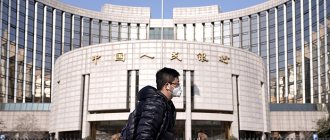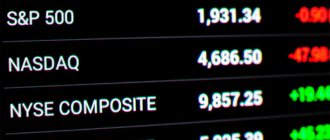Today, in most developed countries of the world, the economic activities of society are organized according to the principle of a market economy. Of course, underdeveloped states continue to exist in which there is a traditional or command model of economic relations, but in the era of globalization, even in them the foundations of a free market begin to emerge (we do not take into account closed totalitarian formations like North Korea).
Such processes are quite natural, since countries with developed market economies show by their example how effective and useful it can be both for the state as a whole and for the individual.
In this article we will analyze in detail what the market model of the economy is, what positive and negative aspects it has, what it is characterized by and by what rules it works.
- What is a market economy
- Characteristics of a market economy
- Signs of a market economy
- Examples
- Market economy: pros and cons
What is a market economy in simple words
Market economy (from the English “Market economy”) is a mechanism for the interaction of all trade turnover with each other, based on private property, commodity-money relations, freedom of choice and competition.
The main features of a market economy are:
- Personal interests;
- Freedom of competition;
- Market pricing;
- Diversity of forms of ownership of the means of production;
- Free Enterprise;
- Contractual relations between business entities;
- Limited government intervention in economic activities;
- Market self-regulation;
- Consumer freedom;
- Limited government intervention in economic activities;
- Free choice of suppliers of raw materials and buyers of products;
Coordination of the actions of participants is carried out directly by the legislative and judicial authorities, and by the executive only indirectly, through the introduction of various taxes, fees, benefits, etc.
On the one hand, a market economy is complete freedom, but on the other hand, there is a tendency for the income gap between rich people and the middle class to increase. The ratio of income of rich and poor people in 1960 was 30:1, and in 2000 it was already 74:1, in 2010 83:1. This difference continues to grow.
American and Swedish market model
1. The American market model implies minimal government intervention in the affairs of companies, a small share of the public sector. Has a strong orientation towards freedom of speech and free competition.
2. The Swedish model implies social protection of the population, namely social spending by the state. Redistribution of income through the budget mechanism (high taxes for the rich). Also supports private property.
- Efficient market theory;
- Shadow economy - what is it;
Types of economic activities
Now in world practice there are several types of market economies. Based on them, each country tries to choose a more effective and successful direction for the development of economic interactions. The most famous types :
- American - the essence of this type is the development of economic relations through entrepreneurial activity, which is widely supported by the state. The part of American residents who do not take part in production and experience many everyday problems is provided with the necessary minimum of social benefits. In the United States, business and entrepreneurship are at their highest point of development, allowing the country to be a leader in the global economy.
- Japanese - this model of a market economy arose against the background of the general development of society and the state on the world stage. Due to the rapid growth of production, the Japanese economy managed to achieve a leading position in the world. The disadvantage of this system is that the welfare of the islanders periodically decreases or remains at the same level. By saving on labor costs, it is possible to reduce the cost of products, which, when entering the world market, become competitive and attractive. This model can only be effective if society and the population are focused on the final result and have a high sense of patriotism.
- Swedish - This country has used functional socialization in its economy for many years. All income is distributed with a view to preventing the enrichment of individuals who are subject to high tax rates. The main national income is spent on socialization objects: education, medicine, the country’s infrastructure, etc.
- German is distinguished by economic activities aimed at the development of small and medium-sized businesses. To achieve this, the government of the country is directly involved in providing assistance and providing consultations to this category of entrepreneurs. The state's planned goal is the successful development of the economic market in order to move it to a higher level.
It is worth noting that the economic model of each country was formed as a result of a long historical process, therefore they are unique in their own way and their borrowing is considered impossible.
What is the modern market
The concepts of “market” and “market economy” are not identical.
The modern market is a system of relationships between producers and consumers.
What are the pros and cons of the modern market?
Pros:
- Economic democracy. Everyone chooses for themselves what and where to buy. All decisions are independent and made independently.
- Resource distribution. The planet's resources and time are spent only on those things that are relevant now.
- There are opportunities to earn money for everyone.
Minuses:
- Monopolism. Large companies are gradually crowding out and buying up small ones. Most of the money goes into the pockets of the richest and most affluent.
- The market only looks in those directions where it can make money. Therefore, many necessary things that do not bring profit remain on the sidelines.
- The pursuit of profit harms the environment and wastes the Earth's resources.
- Unemployment. Companies automate and robotize all possible processes to reduce salary costs for employees.
Concept of a financial market
A financial market is a market where securities (stocks, bonds, derivatives, commodities, currencies) are traded.
- How to buy shares for individuals - detailed instructions;
- Investments in securities - manual;
- How to buy bonds for individuals;
Advantages and disadvantages of the new system
The central link of the modern system is resources (factors of production), which have one common property - their quantity is limited. Fertile lands, minerals, labor, etc. have a specific limit.
Because of these reasons, the volume of production is reduced and, as a result, society is unable to produce enough goods to obtain complete satisfaction. The advantages of a market economy include some factors:
- There is a more rational distribution of resources for production.
- Freedom of choice and economic relations between buyers and entrepreneurs.
- The ability to meet necessary needs, improve the quality of products and services. There is often a tendency for the cost of goods to decrease.
- Flexibility and good adaptation to changing conditions.
- Optimal application of the results of scientific and technological progress.
- The presence of high performance with scant and limited information.
But the modern mechanism has many serious shortcomings. Very often, in market relations, a citizen is not provided with the right to work and to a certain standard of well-being. Since the mechanism is considered unstable, inflationary processes are often observed.
It is almost impossible to make a breakthrough in the field of fundamental science and there is no system for protecting the environment. Ensuring a strong and operational defense capability of the country creates many problems for market relations.
Market functions
Let's consider what useful functions a market economy can perform:
- Regulatory. The market independently determines the most popular products and trends. This ensures a balance between supply and demand in the market.
- The market itself decides what to produce, what customers need now.
- Pricing. Buyers and sellers independently regulate the balance of prices.
- Stimulating. The desire for profit develops technology and makes scientific research justified.
- Distribution and intermediary.
- Sanitizing. The market cleans itself of weak “players” and companies.
- Globalization - what is it;
Examples
An example of a market model of the economy
The market model of the economy is inherent in many states of the modern world. However, it cannot be said that the economic system in them is the same, since each of them has distinctive specific features.
For example, an almost pure market economy existed in the United States in the first decades of the 20th century and was called liberal. It featured free enterprise, an emphasis on healthy competition, minimal government intervention, and investment in markets was largely private.
Subsequently, the American economy has noticeably changed and now there is indirect regulation of markets through monetary and fiscal levers. At the same time, social differentiation is clearly expressed, since there are segments of the population that the current system cannot provide with highly paid jobs, creating instead acceptable living conditions with the help of subsidies, benefits, etc.
In this regard, the market models of the economy in Germany and Sweden are noticeably different, where the reduction of wealth inequalities is one of the important tasks of the state. In particular, the Swedes allocate a significant part of the national income for these purposes, providing the population with jobs, education and insurance.
In the fairly successful English model of a market economy, the condition of focusing on the consumer and private property has been violated. A significant portion of production facilities have a high share of government participation, and government agencies make large purchases and influence market demand.
Japan's market economy is noticeably different from all others. Here, the main market player is corporations with a complex internal structure managed by a legal entity, behind which there are a number of individuals who receive dividends on shares. At the same time, the level of salaries of ordinary employees from the top differs only by 5-6 times, in contrast to the same 15-16 in the USA. In addition, the Japanese place emphasis on concluding long-term employment agreements, obtaining education, providing benefits, advanced training and other socially oriented initiatives.
Well, in some countries where a market economy supposedly exists, only its appearance is created, since the influence of the state on the business sector is peremptory, and the economy rests on only a few industries. It is quite possible to include Venezuela and Russia in this category, whose economies for a long time have been mainly based on oil production.
Classification of markets according to various criteria
By degree of specificity:
- Completely competitive;
- Imperfect competition;
According to their economic purpose, markets are divided into:
- Consumer goods and services;
- Industrial goods;
- Intermediate goods;
- Know-how;
- Raw materials;
- Labor;
- Valuable papers;
- Shadow;
To size
- Local;
- National;
- World;
By degree of competition
- Monopolistic;
- Oligopolistic;
- Free;
- Mixed;
By industry
- Automotive;
- Computer;
- Oil;
By nature of sales
- Wholesale;
- Retail;
What role does competition play?
Competition is the main driver of market development. Manufacturers are fighting among themselves for buyers, so the quality of goods is constantly improving, using more streamlined production processes and modern technologies. Market competition forces prices to decrease.
Types of competition in a market economy
Competition manifests itself in different forms: in pricing, quality of production, production methods, use of innovations, competition for the sale of goods, etc. In terms of scale, competition can be individual (between entrepreneurs), local, national and global (between organizations).
Russian economic model
An interesting aspect is the topic of many earlier and current scientific studies, and most experts agree that our country is dominated by a mixed economy. What does this mean? This is a model where there are freedoms for the private sector, but the state retains the lever of control. Global financiers point out that the weak points of the Russian economy include dependence on gas and oil, corruption, a strong political aspect in the country, as well as the fact that Russia is losing popularity in the investment climate. I propose to look at how types of economies developed depending on the period.
Options for development models of the domestic economy in chronology and their characteristics
| Model name | Period | Peculiarities |
| Economics of High Inflation | 1992-1995 | Political and financial instability |
| "Financial stabilization" | 1995-1998 | Increasing standard of living |
| Crisis and recovery | 1998-2000 | The fall of the national currency, the intensification of crime |
| Active | 2001-2008 | Movement of macroeconomic indicators |
| Crisis | 2008-2012 | Declining indicators, falling living standards |
| Mixed | From 2012 to the present time | Fluctuations in the exchange rate of the national currency, a combination of open and shadow businesses, many unpopular laws from the state |
The world's largest economies in 2022 by GDP
| Place | A country | GDP (trillions US dollars) |
| The whole world | 62,91 | |
| European Union | 16,28 | |
| 1 | USA | 21,44 |
| 2 | China | 14,14 |
| 3 | Japan | 5,15 |
| 4 | Germany | 3,86 |
| 5 | India | 2,94 |
| 6 | Great Britain | 2,74 |
| 7 | France | 2,71 |
| 8 | Italy | 1,99 |
| 9 | Brazil | 1,85 |
| 10 | Canada | 1,73 |
| 11 | Russia | 1,64 |
| 12 | South Korea | 1,63 |
| 13 | Spain | 1,4 |
| 14 | Australia | 1,38 |
| 15 | Mexico | 1,27 |










